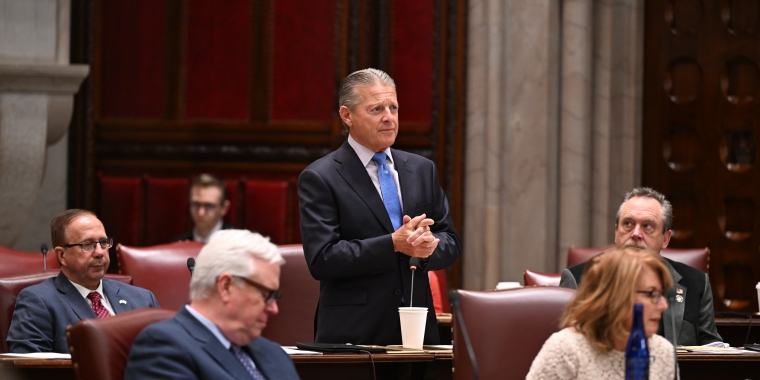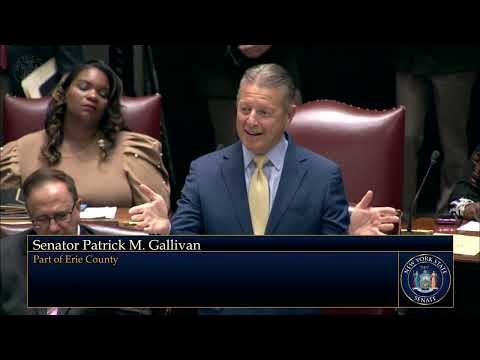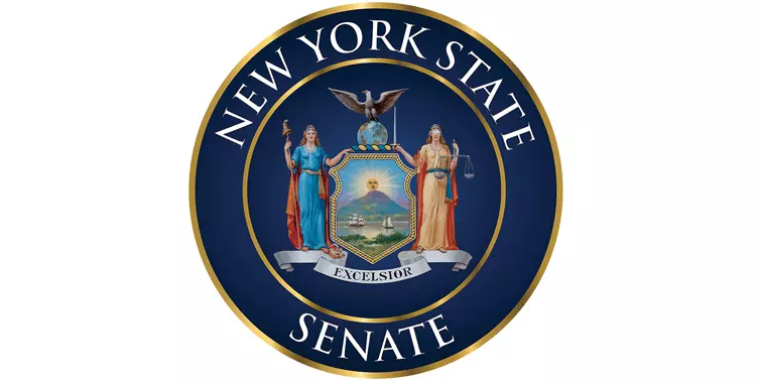
Senate Passes 2012-13 Budget Resolution
Patrick M. Gallivan
March 13, 2012
-
ISSUE:
- Aging
- Agriculture
- Banks
- Families
- Cities

Gallivan: “Senate Plan Cuts Taxes, Reforms Medicaid, Protects Seniors and Schools.”
The New York State Senate voted to approve its 2012-13 Senate Budget resolution, continuing its focus on state spending, job creation, and structural reform to government.
The Senate budget, at just under $132.5 billion, keeps the total state spending increase below two percent, and spends less than the Executive Budget. The budget closes a $2 billion budget deficit and builds on last year’s successes in putting the state’s fiscal house in order.
“To create jobs and invigorate the private sector New York State needs to continue down its path of fiscal restraint. This budget plan respects the taxpayer, cuts taxes on job creators, while finally taking aim at New York’s largest unfunded mandate – Medicaid,” Senator Gallivan said.
The Senate’s resolution freezes the growth of the local contribution of Medicaid costs by beginning the phase-in period in 2012 saving counties $170 million over the next two years. This is nearly identical to a proposal Senator Gallivan has been aggressively pushing since September.
“Medicaid represents the largest state mandated budget item for every county budget in New York State. I included a freeze of the local share of Medicaid in my original legislation because county governments will crumble under the strictures of the property tax cap without significant and immediate mandate relief, specifically from Medicaid,” said Gallivan. “An immediate freeze of the local share of Medicaid will allow local governments to hold the line on property taxes, without eliminating vital programs citizens rely on.”
The Senate budget also includes a comprehensive job creation plan that would cut taxes on businesses; as well as provide additional aid to rural schools, more mandate relief for localities, tuition help for middle class families and, for senior citizens, more property tax relief and greater assistance for prescription drug costs.
JOB CREATION & HELPING SMALL BUSINESSES
· Reducing the corporate tax rate for small businesses from 6.5 percent to 5.2 percent and eliminating the fixed dollar minimum; this would result in a 20 percent tax cut for small businesses and save almost 200,000 small businesses $65 million;
· A 10 percent tax credit for 800,000 small businesses that pay under the personal income tax will save them $120 million;
· Accelerating the end of the 500 percent energy tax increase imposed by Senate Democrats from the current expiration date in 2014 to 2013 will save $300 million dollars, especially key Western New York industries that are high energy consumers like manufacturing and agriculture;
· A new job creating incentive would give businesses a tax credit of up to $5,000 for each new job they create; or up to an $8,000 credit if the job goes to someone on unemployment; or up to a $10,000 credit if a business hires a returning military veteran; and
· Tying existing tuition tax credits and deductions enacted in 2000 to the Higher Education Price Index to provide tuition relief for middle class families and ensure that assistance keeps pace with the increasing costs of higher education.
Also included in the Senate’s budget were items long sought by the Senate Majority, including; enacting a two percent state spending cap; requiring a super-majority vote to increase state taxes; a moratorium on new taxes and fees; and continued regulatory reform to cut expensive red tape for employers.
MANDATE & PROPERTY TAX RELIEF
Aside from incorporating Senator Gallivan’s Medicaid freeze proposal, the Senate budget resolution rejects any proposed mandates and costs shifts to localities. It also includes municipal finance reform incentive aid to provide property tax relief for homeowners and mandate relief for localities.
WESTERN NEW YORK SCHOOLS
The Senate budget restores $200 million in school aid cuts mainly targeted to low wealth and upstate rural districts by reallocating proposed spending.
“Rural schools, already disproportionately impaired by a structurally flawed educational aid formula and declining tax bases, were hit the hardest in last year’s education cuts,” said Gallivan. “Rural districts across Western New York rely on state aid far more than the wealthy districts surrounding New York City and on Long Island, and I firmly believe the most responsible and equitable way to distribute available education aid is on the schools and the students who need it the most.”
Senator Gallivan authored a letter in February, urging the Governor to utilize existing school funding to restore inequitable cuts incurred by rural schools in last year’s budget. Eleven of his fellow upstate Senators also signed the letter.
RESTORATION OF TRANSPORTATION AID
A mathematical error in the 2008 transportation budget resulted in the Department of Transportation’s Region 6, encompassing Western New York, to be shortchanged $167 million in capital funding for infrastructure improvements. The Senate budget includes language to restore this vital money for Western New York roads and bridges.
ASSISTANCE FOR SENIOR CITIZENS
Under the Senate budget plan, senior citizens eligible for the Enhanced STAR program would receive $275 million in direct property tax rebate checks.
In addition, $48.2 million would be used to restore the Elderly Pharmaceutical Insurance Coverage Program (EPIC) to reduce copayments for seniors to a maximum of $20.
Share this Article or Press Release
Newsroom
Go to Newsroom


